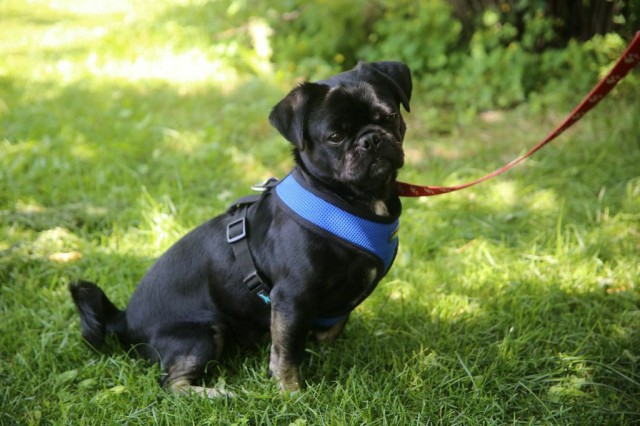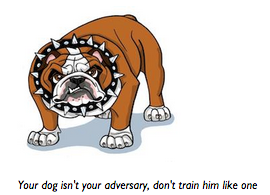I recently had the pleasure of working with Joan Weston (AKA Magic Hands) of Fangs But No Fangs who specializes in Canine Behavioural Consulting and how to train a reactive dog.
I contacted her to help my foster dog Kilo the Pug interact more safely with new people and dogs. I love her motto “Your dog isn’t your adversary, don’t train him like one”.
Her approach is based on science, research and mutual respect. Even if you don’t love your dog’s behavior, you still love your dog. Helping them shouldn’t be an adversarial battle based on fear, pain or outdated opinions.
At Fangs But No Fangs, they understand that you and your dog are on the same team, working together. When you act with compassion and intelligence, great things can happen for you both.

Joan reviewed basic principles with me, some of which are based on the theories of Dr Rhea Dodd, DVM, MA, IVAS and CSU Certified Veterinary Acupuncturist and IVCA Certified in Veterinary Chiropractic a.k.a. Gentle Vet
- Dogs don’t do things out of spite, or to make your life miserable. They do what works – to get things they like and to avoid what they don’t like.
- Behaviour that is rewarded usually increases. Behaviour that is punished usually decreases (but we are not big on punishment, more removal of rewards).
- Timing is everything. Rewards must be delivered immediately after the animal starts the behaviour. A delay of even a few seconds will make it difficult for your pet to learn.
- To change behaviour you have to be patient and persistent. Change will not happen over night and some things may be very tough to change. The more you work the quicker the change.
- Set your dog up for success. Arrange the learning environment so that the behaviour you want is easily produced. If you can be consistent about only working him in situations where he cannot rehearse the unwanted behaviour, you’ll really see improvement.
- Shape behaviour gradually starting with the easiest and simplest thing. Always work slowly, use tiny steps and build off success. If your dog is not succeeding, stop, go back to a previous step and rebuild.
She suggested that I get a longer leash that is fixed around my waste so Kilo doesn’t feel me adjusting to where he wants to go on a walk. I am in control and I have both hands free to work with him.
She also suggested I add in some really special “high value” great smelling treats like chicken, meat, hot dogs or cheese for the more stressful training exercises.
Kilo absolutely loved Joan, a total stranger. As soon as he realized she had meatballs and hot dogs in her pockets, he could not have been more eager to please.

Here are a few more dog training tips that Joan shared:
“Go to Bed” – give your dog a place to go and relax when someone comes to the door.
Every time the door bell rings, grab a Kong full of frozen yummies, or some high value treats and take your dog to his or her crate or bed to enjoy it. Then go and greet the person at the door while the dog is busy enjoying a treat.
Have someone familiar ring the door bell a few times during the day and every time the bell rings, give them the kong in the crate or on their bed and don’t even have the person come in.
The dog should realize that they will get a reward when the doorbell rings if they go to their crate or bed, rather than shouting at strangers and trying to intimidate them.
I now have a 4 Kongs in the freezer at any time, filled with different delicious recipes (banana and peanut butter, blended cooked beans or carrots or sweet potato, chicken, minced meat). Kilo has been way better with visitors.
I actually now get Kilo to jump up on a seat and do tricks for treats when strangers come. It distracts him and seems to give him confidence being up higher and showing off (he loves treats and an audience). Then once he has impressed them with his tricks, he gets down and meets them.
Magic Hand Pat
This exercise teaches your dog that hands reaching out are good things, and that if he initiates contact, he will earn a reward. Many dogs like Kilo are fearful of hands, especially if they’re looming overhead, or shoot out to pet.
Start with your hand held horizontally over the dog’s head, your other hand holding a treat at nose level. The dog brings his head under your outstretched hand to get his treat. Depending on how fearful the dog is, you may start with this hand hovering over his head, not touching it yet, or just barely grazing his ears.
As the dog gets more comfortable with the hovering hand, bring it closer to the top of his head as he reaches for his treat until you are petting him gently on the head as he moves forward. This stage may take many sessions to reach; do not push the dog too fast. Many short trials throughout the day will get you farther than one long one
It is extremely important not to bring your hand closer until he is happy and waggy at the previous level. Once the dog knows the game and is happily “self-petting”, start fading the treat out of the picture, moving your hand further back, without a treat in it, and rewarding after the dog performs his part of the deal, moving his head under your hand.
The goal is for your dog to see an outstretched hand and to run and put his head underneath it.
Hand Targeting
Teach your dog to target your own hand (touch it with his or her nose), then have a friend hold his or her hand where yours was and ask him or her to touch it, then gradually moved her away. “Say Hello!”, he’ll look around for the nearest outstretched hand, run over and touch it, then run back to me for his reward.
How to Introduce Strangers to a Reactive Dog
Have the stranger toss treats on the ground and ignore the dog by turning sideways or away from them. Let the dog get familiar with their smell.
Don’t have them reach out to pat or hand feed. Don’t get too close too quickly. Eventually, and only if the stranger and the dog are both relaxed and happy, and the person is sitting down, let the dog approach their hand for a treat (I usually still keep my hand there at first).
Kilo takes a while and often appears aggressive, especially to tall men or when people suddenly start moving around in the house or on the street. However once he knows someone’s scent, and associates them with treats, he’ll settle down and even initiate petting. He is a greedy pug after all.
He also likes kids and is usually friendly to them right away unless they are on bikes or skate boards and scare him.
Share more tips or questions in the comments below.


These are great tips – understanding that your dog isn’t doing things just to be bad, or out of spite is such an important lesson to learn. And realizing that good behaviors increase with positive reinforcement is invaluable to all dog owners – they really do look to us for direction and thrive on feeling like they’ve made the right decisions by us. I should definitely practice the magic hand technique – when we’re out at the park many children rush up and pet her and although she doesn’t exhibit signs of distress it always makes me a bit uneasy.
Thanks Jen. I agree. Joan’s tips have been so great. I have to be so careful as Kilo gets quite distressed sometimes.